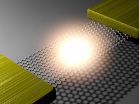(Press-News.org) New York, June 15 -- Led by Young Duck Kim, a postdoctoral research scientist in James Hone's group at Columbia Engineering, a team of scientists from Columbia, Seoul National University (SNU), and Korea Research Institute of Standards and Science (KRISS) reported today that they have demonstrated -- for the first time -- an on-chip visible light source using graphene, an atomically thin and perfectly crystalline form of carbon, as a filament. They attached small strips of graphene to metal electrodes, suspended the strips above the substrate, and passed a current through the filaments to cause them to heat up. The study, 'Bright visible light emission from graphene,' is published in the Advance Online Publication (AOP) on Nature Nanotechnology's website on June 15.
'We've created what is essentially the world's thinnest light bulb,' says Hone, Wang Fon-Jen Professor of Mechanical Engineering at Columbia Engineering and co-author of the study. 'This new type of 'broadband' light emitter can be integrated into chips and will pave the way towards the realization of atomically thin, flexible, and transparent displays, and graphene-based on-chip optical communications.'
Creating light in small structures on the surface of a chip is crucial for developing fully integrated 'photonic' circuits that do with light what is now done with electric currents in semiconductor integrated circuits. Researchers have developed many approaches to do this, but have not yet been able to put the oldest and simplest artificial light source -- the incandescent light bulb -- onto a chip. This is primarily because light bulb filaments must be extremely hot -- thousands of degrees Celsius -- in order to glow in the visible range and micro-scale metal wires cannot withstand such temperatures. In addition, heat transfer from the hot filament to its surroundings is extremely efficient at the microscale, making such structures impractical and leading to damage of the surrounding chip.
By measuring the spectrum of the light emitted from the graphene, the team was able to show that the graphene was reaching temperatures of above 2500 degrees Celsius, hot enough to glow brightly. 'The visible light from atomically thin graphene is so intense that it is visible even to the naked eye, without any additional magnification,' explains Young Duck Kim, first and co-lead author on the paper and postdoctoral research scientist who works in Hone's group at Columbia Engineering.
Interestingly, the spectrum of the emitted light showed peaks at specific wavelengths, which the team discovered was due to interference between the light emitted directly from the graphene and light reflecting off the silicon substrate and passing back through the graphene. Kim notes, 'This is only possible because graphene is transparent, unlike any conventional filament, and allows us to tune the emission spectrum by changing the distance to the substrate.'
The ability of graphene to achieve such high temperatures without melting the substrate or the metal electrodes is due to another interesting property: as it heats up, graphene becomes a much poorer conductor of heat. This means that the high temperatures stay confined to a small 'hot spot' in the center.
'At the highest temperatures, the electron temperature is much higher than that of acoustic vibrational modes of the graphene lattice, so that less energy is needed to attain temperatures needed for visible light emission,' Myung-Ho Bae, a senior researcher at KRISS and co-lead author, observes. 'These unique thermal properties allow us to heat the suspended graphene up to half of temperature of the sun, and improve efficiency 1000 times, as compared to graphene on a solid substrate.'
The team also demonstrated the scalability of their technique by realizing large-scale of arrays of chemical-vapor-deposited (CVD) graphene light emitters.
Yun Daniel Park, professor in the department of physics and astronomy at Seoul National University and co-lead author, notes that they are working with the same material that Thomas Edison used when he invented the incandescent light bulb: 'Edison originally used carbon as a filament for his light bulb and here we are going back to the same element, but using it in its pure form -- graphene -- and at its ultimate size limit -- one atom thick.'
The group is currently working to further characterize the performance of these devices -- for example, how fast they can be turned on and off to create 'bits' for optical communications -- and to develop techniques for integrating them into flexible substrates.
Hone adds, 'We are just starting to dream about other uses for these structures -- for example, as micro-hotplates that can be heated to thousands of degrees in a fraction of a second to study high-temperature chemical reactions or catalysis.'
INFORMATION:
The research was conducted by researchers from Columbia Engineering, Seoul National University, Korea Research Institute of Standards and Science, Konkuk University, Sogang University, Sejong University, University of Illinois at Urbana-Champaign, and Stanford University.
This work was supported by the Korea Research Institute of Standards and Science under the auspices of the project 'Convergent Science and Technology for Measurements at the Nanoscale' (15011053), grants from the National Research Foundation of Korea (2014-023563, NRF-2008-0061906, NRF-2013R1A1A1076141, NRF-2012M3C1A1048861, 2011-0017605, BSR-2012R1A2A2A01045496 and NMTD-2012M3A7B4049888) funded by the Korea government (MSIP), a grant (2011-0031630) from the Center for Advanced Soft Electronics through the Global Frontier Research Program of MSIP, the Priority Research Center Program (2012-0005859), a grant (2011-0030786) from the Center for Topological Matters at POSTECH, the NSF (DMR-1122594), AFOSR (FA95550-09-0705), ONR (N00014-13-1-0662), Army Research Office (ARO) grant W911NF-13-1-0471 and the Qualcomm Innovation Fellowship (QInF) 2013.
Paper: 'Bright visible light emission from graphene': The DOI for the paper will be 10.1038/nnano.2015.118. Once the paper is published electronically, the DOI can be used to retrieve the abstract and full text from the Nature website by adding it to the following URL: http://dx.doi.org/.
Columbia Engineering: http://engineering.columbia.edu/
Video: https://youtu.be/DaxKbATmTCE
Diatoms in the world's oceans exhale more oxygen than all the world's rainforests. These tiny drifting algae generate about 20 percent of the oxygen produced on Earth each year and invisibly recycle gases enveloping our planet.
How diatoms will respond to the rising carbon dioxide levels is still unknown. A new study by the University of Washington and Seattle's Institute for Systems Biology, published June 15 in Nature Climate Change, finds the genetic ways that a common species of diatom adjusts to sudden and long-term increases in carbon dioxide.
'There are certain ...
Does participation in the annual lung cancer screening currently recommended for people with high-risk smoking histories encourage those who are still smoking to quit? A new study from a Massachusetts General Hospital research team (MGH) finds that the answer may depend on the level of support given by patients' primary care providers. In the report receiving online publication in JAMA Internal Medicine, the team finds that, while providers' asking such patients about smoking did not increase their likelihood of quitting, providing more direct assistance - such as talking ...
LOS ANGELES -- New research by an international team including Keck Medicine of USC scientists is bringing the origins of ovarian cancer into sharper focus.
The study, published online June 15 in the peer-reviewed journal Nature Genetics, highlights the discovery of three genetic variants associated with mucinous ovarian carcinomas (MOCs), offering the first evidence of genetic susceptibility in this type of ovarian cancer. The research also suggests a link between common pathways of development between MOCs and colorectal cancer and for the first time identifies a gene ...
TORONTO, June 15 -- Researchers in Canada and the U.K. have for the first time sequenced and assembled de novo the full genome of a living organism, the bacteria Escherichia Coli, using Oxford Nanopore's MinIONTM device, a genome sequencer that can fit in the palm of your hand.
The findings, which were published today in the journal Nature Methods, provide proof of concept for the technology and the methods lay the groundwork for using it to sequence genomes in increasingly more complex organisms, eventually including humans, said Dr. Jared Simpson, principal investigator ...
A new study, published in the British Journal of Sociology of Education, has found that while students' unions often try to oppose the rise of consumerism at their universities, they are rarely successful.
The team of researchers at the University of Surrey arranged various focus groups at 10 higher education institutions, with both students' union leaders and university managers. They found that the nature of relationships between unions and their university often makes it difficult for students' unions to reject consumerism - either because they have little independence ...
Over the past nine years, Scot H. Simpson, professor in the faculty of Pharmacy and Pharmaceutical Sciences at the University of Alberta, has been studying the role of pharmacists on primary care teams and their impact on the health of patients with Type 2 diabetes.
His most recent study, Pharmacists on primary care teams: Effect on antihypertensive medication management in patients with Type 2 diabetes, published in the May/June issue of the Journal of the American Pharmacists Association, found that having pharmacists on primary care teams had a significant impact ...
If you leave your job, chances are your pattern of cellphone use will also change. Without a commute or workspace, it stands to reason, most people will make a higher portion of their calls from home -- and they might make fewer calls, too.
Now a study co-authored by Massachusetts Institute of Technology researchers shows that mobile phone data can provide rapid insight into employment levels, precisely because people's communications patterns change when they are not working.
Indeed, using a plant closing in Europe as the basis for their study, the researchers found ...
From heat waves to damaged crops to asthma in children, climate change is a major public health concern, argues a Michigan State University researcher in a new study.
Climate change is about more than melting ice caps and images of the Earth on fire, said Sean Valles, assistant professor in Lyman Briggs College and the Department of Philosophy, who believes bioethicists could help reframe current climate change discourse.
"When we talk about climate change, we can't just be talking about money and jobs and polar bears," he said. "Why do we focus on polar bears? Why ...
The National Hurricane Center is keeping a close eye on a developing tropical low pressure area in the south-central Gulf of Mexico. NOAA's GOES-East satellite provided imagery of the system, and an animation was created at NASA showing the development over two days. The system has a high chance for development into a tropical depression.
NOAA's GOES-East satellite sits in a fixed location providing continuous coverage of weather systems in the eastern U.S. and Atlantic Ocean basin. An animation of visible and infrared imagery of the low was created by NASA/NOAA's GOES ...
An international research team has found a way of protecting sensitive catalysts from oxygen-caused damage. In the future, this could facilitate the creation of hydrogen fuel cells with molecular catalysts or with biomolecules such as the hydrogenase enzyme. To date, this could only be accomplished using the rare and expensive precious metal platinum. Together with their French colleagues, researchers from Bochum and Mülheim describe the way in which a hydrogel can serve as a "protective shield" for biomolecules by two articles written in the journals Angewandte Chemie ...



